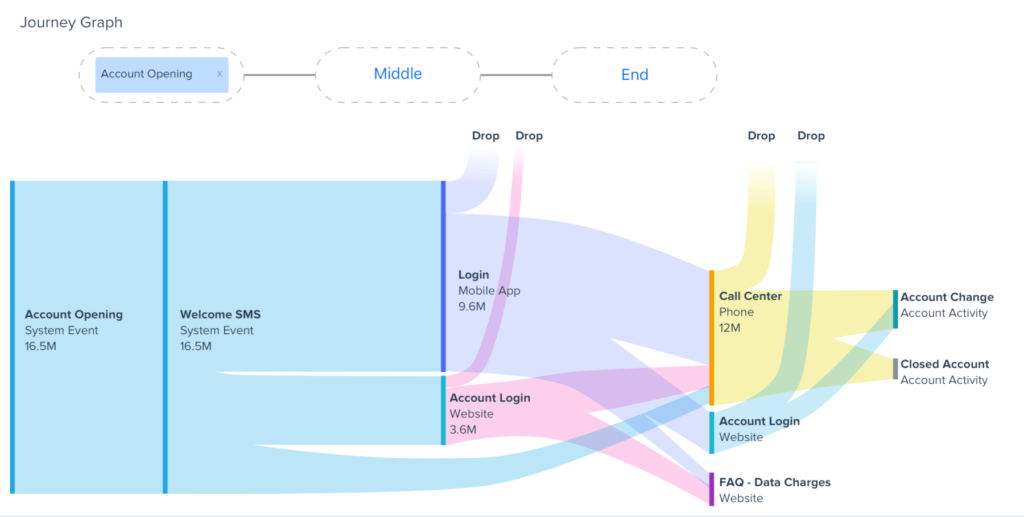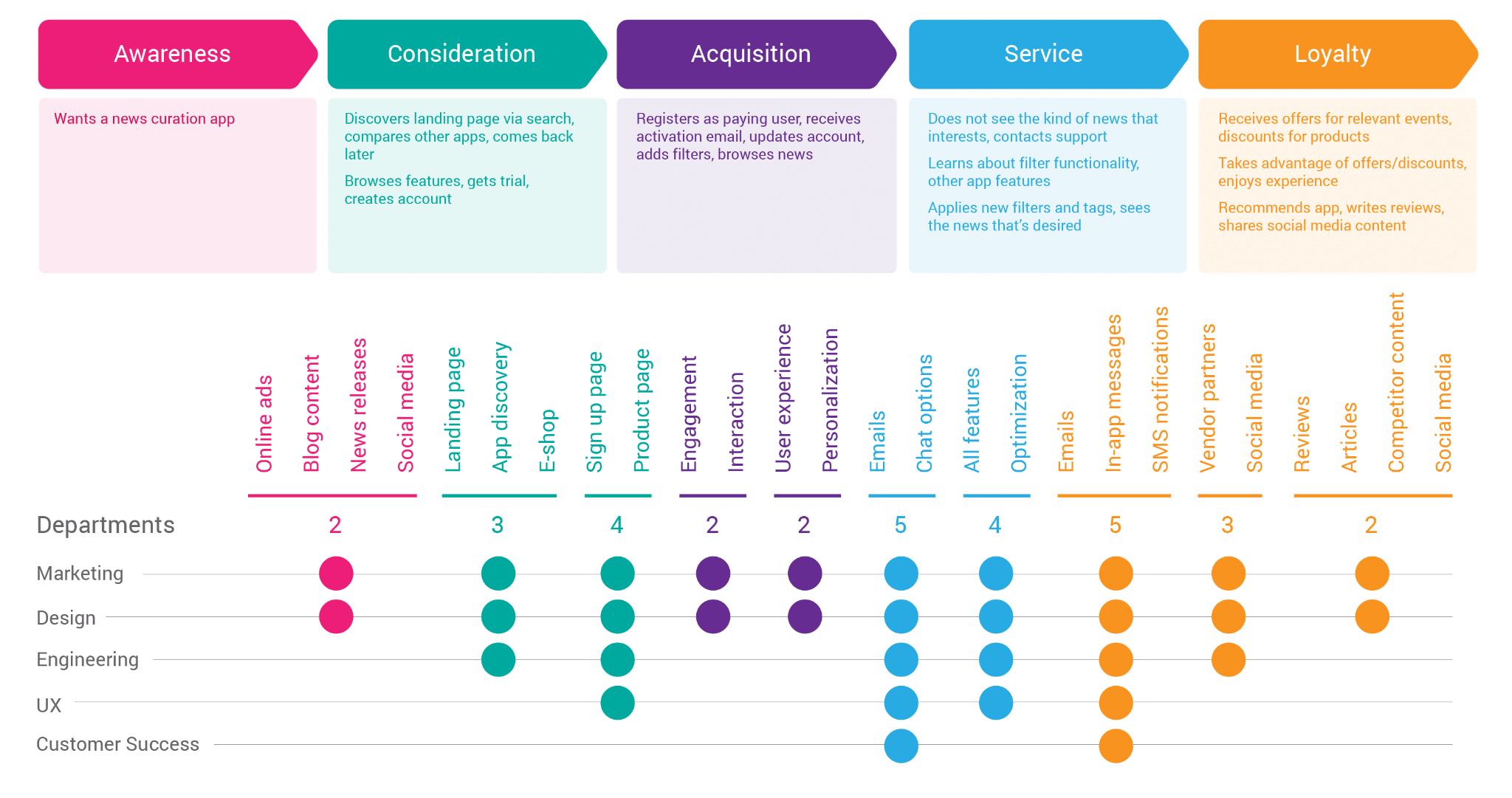Having a great website, a strong social media presence, and a solid marketing strategy sometimes fail to get expected conversions.
It happens because marketing managers ignore how customers or users interact with their website. Even if they do, they look at single touchpoints instead of the bigger picture.
This means hundreds if not thousands of dollars wasted on ad spending, which could have been saved.
Here we will look at how marketers can drastically increase their conversions by analyzing each and every touchpoint throughout the customer journey.
Understanding the Customer Journey & Touchpoints
Before we start discussing how to boost your conversion rate, let’s first understand what a customer journey is about.
The customer journey is a step-by-step process that customers go through when interacting with a website or an app.
It consists of various stages and touchpoints that play a crucial role in influencing their decision-making and ultimately impacting conversions. The touchpoints include various digital or customer relationship management (CRM) touchpoints.
The customer journey comprises of 4 key stages:
1. Awareness Stage
When you are introducing your product or service in the market, the prospect is not aware about it. In this case, you need to raise awareness through different marketing efforts like social media campaigns, paid advertising, search engine optimization, and content marketing.
Building a strong brand presence and capturing the attention of potential customers is crucial. The important touch points may include your website, application, social media post, blog post or video.
2. Consideration Stage
In this stage, prospects are aware of their needs and also about the products or services that can fulfill their needs. But they are not sure which one would be the best for them.
So, they actively research and evaluate different options and weigh their pros & cons before zeroing down to the final decision.
For evaluation, they read reviews from other customers, compare features and pricing, or consume educational content like whitepapers or webinars. These serve as key touchpoints for a brand to give the customers crucial information to make a favorable choice.
And for marketing teams, this is the most important stage as it also includes nurturing the lead and passing them over to the sales team to convert that qualified lead.
3. Purchase Stage
This is the stage where prospects make their final decision to purchase the product or service.
The touchpoints in this stage may include free trials, product demos, pricing discussions, and direct communication with sales representatives.
Since this is the most important stage for any business, a significant amount of effort is made to convince the prospect to buy from them.
4. Retention Stage
The customer journey doesn’t end at purchase. Businesses need to retain customers by offering loyalty programs, discounts on repeat purchases, referral bonuses, and excellent customer support.
The goal here is to make the first-time customer a loyal customer, which not only gives repeat business but brings other customers too.
Now that we are familiar with the customer journey let’s explore how customer journey analytics can provide valuable insights to optimize conversions at each stage of the customer journey.
Customer Journey Analytics: What is It and How to Use?
Organizations use customer journey analytics to measure and improve their customer experience and, at the same time, identify gaps that deter conversions.
It gives you insights about customer behavior that helps marketing teams to strategize every touchpoint for optimal business performance.
To better understand it, let’s first explore what customer journey analytics actually means and its components.
Meaning of Customer Journey Analytics
Customer journey analytics is a methodical approach to analyzing customer behavior across different touchpoints to measure the impact of their activity on business performance.
With customer journey analytics data, teams gain insights into every customer touchpoint, which enables them to view a complete picture. Instead of solely relying on one source, e.g. customer feedback, they can see exactly what steps a customer took before making the purchase.
Customer journey analytics can be done through real-time analytics, predictive analytics, customer segmentation, and other methods, depending on the organization’s needs and strategy.
Components of Customer Journey Analytics
To analyze the key touchpoints across the customer journey, marketers must understand the key components involved in this process.
1. Data Collection
To analyze the data, you need to capture it first. Marketers collect and consolidate data from multiple sources, such as website analytics, CRM module of your ERP, marketing automation platforms, and more. This data is then fed to the models to start the analysis process.
2. Data Analysis
Once the data is collected, marketers decode meaningful patterns and trends. Here they use advanced analytics techniques, such as segmentation, predictive modeling, and machine learning algorithms, to identify key insights.
This analysis helps businesses understand customer behavior, preferences, and pain points at each stage of the journey.
3. Visualization and Mapping
Customer journey mapping refers to creating a visual story of the customer experience that includes all the touchpoints across different stages.
It is a powerful way to gain a holistic view of the entire experience from the customer’s perspective, highlighting key moments of truth and avenues for optimization.

4. Touchpoint Analysis
In marketing, touchpoints refer to the points of contact between the company and the customer. Through touchpoint analysis, marketers can assess the performance of individual touchpoints, identify bottlenecks hindering customer engagement and optimize them.
During the purchase process, the customer encounters different touchpoints and they can be broadly classified as:
- Influencing Touchpoints: These refer to information search and finding information.
- Pre-Purchase Touchpoints: They help in the preparation of a decision that is not still taken.
- Purchase Touchpoints: They influence the purchase decision made by the customer.
- After-Purchase Touchpoints: They assist in any kind of support regarding usage and repurchase of the product or service.
- Influencing Touchpoints: These touchpoints help the customer to influence others to buy a company’s offerings.
5. Behavioral Segmentation
Behavioral segmentation refers to identifying the target audience based on how they interact with a product or an app.
Grouping customers with similar behavior and usage patterns, businesses helps to predict the next-best action and create personalized marketing communication strategies. This approach increases the chances of converting leads into paying customers.
Overall if all of these are put together, it would look something like this:

Optimizing Conversions With Customer Journey Analytics
As we saw above, the customer journey comprises of 4 key stages, from Awareness to Retention. Each stage has multiple touchpoints, and by assessing them we can fix the gaps to improve the customer rate.
Let’s now look at how to optimize each stage of customer journey with help of analytics:
1. Awareness Stage
Measuring awareness is one of the trickiest parts of customer journey analytics. To be discovered during this early phase, online visibility is key.
The prospects come across several touchpoints at this stage, which include:
- Advertisements (Online & Offline)
- Media Mentions (PR)
- Search Results
- Social Media
- Blog Posts
- Podcasts
- Webinars
- Videos
Here, marketers need to measure different KPIs to gauge the level of brand awareness:
- Reach & Impressions
- Search Ranking
- Website Traffic
- Time on Page
- Bounce Rate
- Pages per visit
These metrics can be optimized by creating a user-friendly and SEO website, crafting compelling social media creatives, using appropriate keyword match types, and geo-targeting.
2. Consideration Stage
The consideration stage is all about educating the prospects and making them see why choosing you is a no-brainer.
The touchpoints at this stage can be:
- Search and display ads
- Specific product/service landing pages
- Blogs
- Whitepapers
- Comparison videos
- Customer reviews
The effectiveness of marketing efforts at the consideration stage can be measured by following metrics:
- Click Through Rate (CTR)
- Cost Per Click (CPC)
- Engagement rate (No. of likes, comments, shares)
Here, optimization can be done through A/B testing, analyzing heatmaps, bidding on long-tail keywords, tweaking headlines and copy and improving visual design of your marketing content.
3. Purchase Stage
Now that the prospect has made a decision to buy from you, it’s important to convert them at all costs. You have opportunities to convince them through:
- Website
- Customer reviews
- Testimonials
- Case studies
- Sales team
- Customer service team
- Events
- Through distributors or retailers
- Physical or online store
- Checkout page / Point of Sale (POS)
The important KPIs you can use to measure your success at this stage:
- Conversions / Conversion rate
- Sales
- Cost per Acquisition (CPA)
By crafting a convincing headline and content, A/B testing, analyzing sales data, identifying best-performing landing pages and ads, you can optimize metrics at purchase stage.
4. Retention Stage
This stage is equally important as the purchase stage, as every business wants customers to keep coming back for more. To retain customers, marketers reach out to them via:
- Customer service/support
- Feedback forms/calls
- Email marketing
- Referral programs
- Loyalty programs
Key metrics that marketers must track here:
- Net Promoter Score (NPS)
- Customer Satisfaction Score (CSAT)
- Churn rate
- Retention rate
- Customer Lifetime Value (CLTV)
In order to maximize the effectiveness of retention programs, companies should consider recording and analyzing user sessions on their website or an app to see what causes them to drop off. Along with that, they should collect feedback on a regular basis to update their offerings commensurate with customer expectations.
Final Thoughts
Customer Journey Analytics is a powerful and important method of assessing a customer’s behavior and its impact on marketing performance.
To start with, marketers must empathize with customers and experience their offerings firsthand. This will enable them to go through the exact same process that a customer would have to go through and find opportunities for improvement.
For example, If you were a potential customer, what things would you look at to gain information about the business? Would you go through its website, social media, or ads? What would drive you to pull the trigger and make a purchase? If you were having an issue, what customer support services would you seek out? These questions and more will help you optimize your customer journey.
Last but not least, using various analytical tools like Hotjar, Google Analytics, Mixpanel, Survey Monkey, etc., help determine customers’ needs and actual behavior. The insights obtained from these tools would help you identify which metrics to pay attention to optimize your conversions.
The post How to Optimize Conversions With Customer Journey Analytics appeared first on Datafloq.

